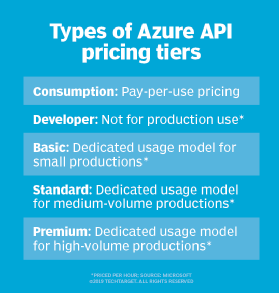
agsandrew - Fotolia
Azure API Management consumption tier targets serverless
Azure's API Management consumption tier is built to manage serverless APIs, but it lacks many features users take for granted. Find out if its benefits outweigh the drawbacks.
As serverless development grows in popularity, it becomes critical to have a more targeted platform and API pricing structure that understands the strengths and challenges of the technology.
API management is commonly focused on traditional hosting strategies, with many bare-metal, virtualized and cloud-based tools available on the wider market. But, at their core, those services all tend to rely on one thing: permanence.
That's not the case with the latest version of the Microsoft Azure managed service for API publishing. The API Management consumption tier is built around serverless principles. It's an ephemeral, on-demand API management tier for both serverless and serverless-adjacent back ends. With autoscaling and high availability included, the consumption tier gives developers who rely on serverless technologies the same power typically reserved for more comprehensive APIs. This, in turn, treats these serverless APIs as first-class citizens in a rapidly evolving market.
External caching
The external caching feature is exclusive to the consumption tier, which falls in line with ephemeral application architectures. While an immediate benefit to using an external cache is that it's retained between service cycles, the cache also provides a good direction for developers that want to get the most out of a serverless API management platform.
The consumption tier emphasizes the importance of using long-running services -- where appropriate -- to ensure the proper resources are being used for the job. By externalizing the cache, it's clear that the entire API Management platform is built with serverless in mind. It also means developers who use this tier need to change the way they approach some of the goals typically achieved through features such developer portals and analytics platforms.
Limitations
While the Azure API Management consumption tier is resource-focused, the benefits it provides are offset by a number of limitations that are not found in the developer, basic, standard and premium pricing tiers.

The consumption tier does not have security-leaning features, like advanced SSL (Secure Sockets Layer) configurations and client certificate authentication, despite being made available in the other Azure API Management tiers. Other features typically associated with API management platforms are absent as well, such as a developer portal, built-in analytics, disaster recovery, and logging and metrics.
Many of these features may be left out due to technical limitations. It's also possible that they weren't included because serverless implies no idling. While a typical web-based service sits around and waits to do something, serverless services do not. Serverless functions disappear entirely until they are needed, which is beneficial because this can help cut costs. However, any services built with those principles in mind must tolerate the full-stop behavior exhibited by serverless platforms.
So, while the consumption tier lacks many of the API management features users take for granted, a serverless front end can, in many ways, make up for those shortcomings. Ultimately, it comes down to knowing the needs of your APIs and your organization.








